In this article:
Muscle pain is a common discomfort that afflicts almost everyone at one point or another. It can be the result of muscle tension, injury, or overuse, in which case it is limited to the affected area.
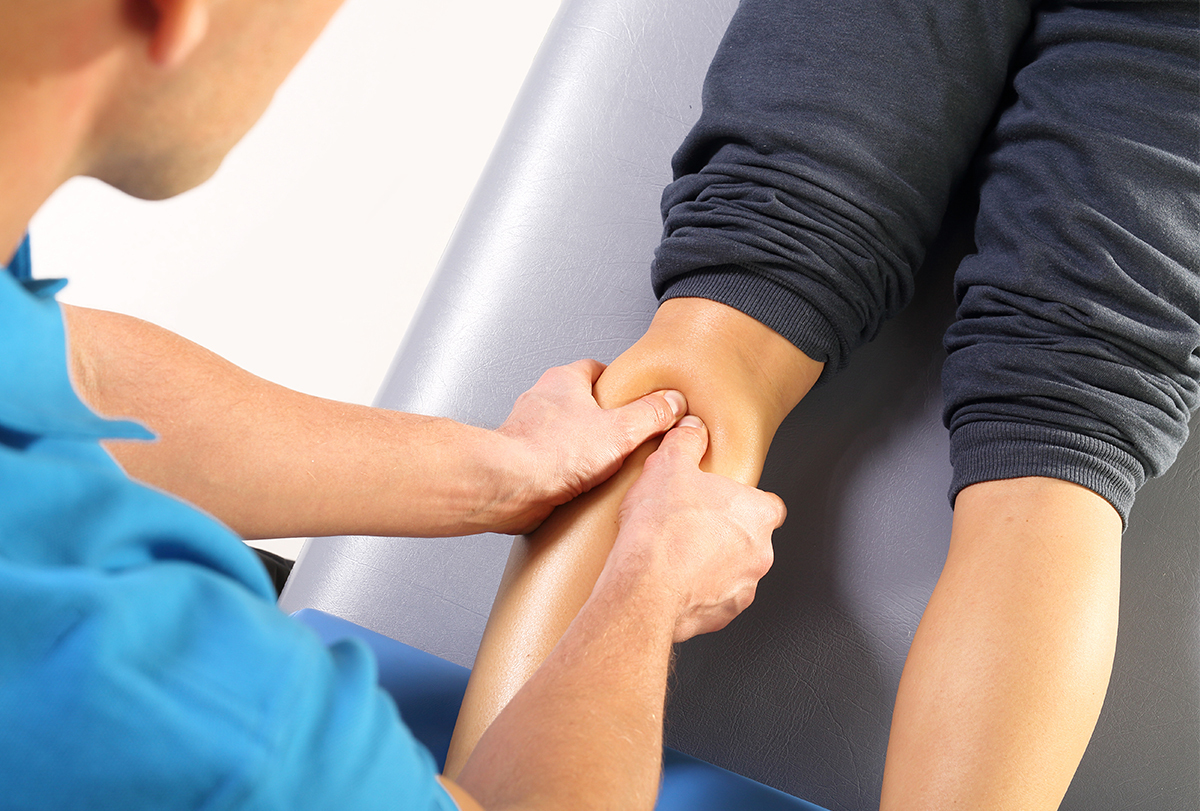
However, muscle pain that can be felt all over the body is either a side effect of certain medication or symptomatic of some illness or infection.
Although treatment for muscle pain usually depends on the underlying cause, here are some general self-care tips and home remedies that can help you get relief.
First-Line RICE Treatment for Immediate Relief
The preliminary treatment for regular type of muscular ache, pain, sprain, or strain involves a multiple-step regimen called RICE, which stands for rest, ice, compression, and elevation.
RICE entails:
- Resting the affected muscle for at least 48 to 72 hours.
- Icing the injury site with a cold pack for 10–20 minutes every 2–3 hours to numb the pain.
- Compressing the affected body part using a firm elastic pressure bandage to curb swelling.
- Elevating the injured body part by keeping it in a raised position or on top of a pillow to bring down the swelling.
Do this continuously for the first 2–3 days after any soft tissue injury for pain relief.
Home Remedies for Muscle Pain
Antioxidant-rich foods can help counter the activity of free radicals, promote tissue repair, and thereby relieve muscle pain or soreness. (1) Here are some beneficial ingredients that can help your sore muscles heal faster.
1. Eat more tart cherries
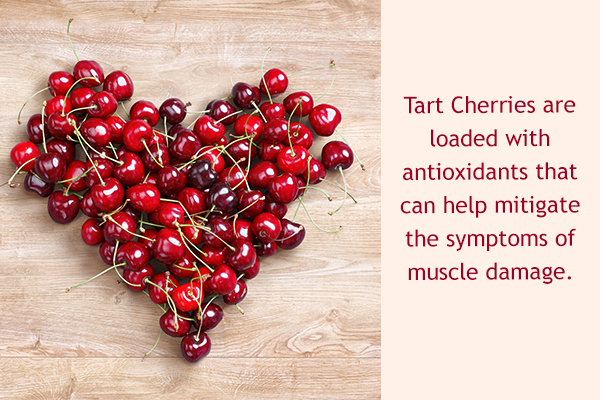
Tart cherries are loaded with antioxidants that can help mitigate the symptoms of muscle damage.
Consuming tart cherry juice or tart Montmorency cherry concentrate before and during strenuous physical training can help reduce post-exercise muscle soreness and promote tissue recovery. This nutritional intervention is particularly helpful for endurance athletes and women as a means to manage muscle pain. (2)(3)
How to use:
- You can eat whole tart cherries as part of your regular diet.
- Tart cherry juice contains concentrated amounts of antioxidants and is often used as an energy drink post-workout. But it may contain copious amounts of sugar, which is why you need to consume it in recommended amounts for it to be truly healthy.
- You can also derive the nutritional goodness of tart cherries from commercially available supplements, but always consult your doctor regarding its safety and proper dosage before starting.
Tart cherries are loaded with antioxidants that can help mitigate the symptoms of muscle damage.
2. Increase your ginger intake
Multiple studies have shown that ginger supplementation can help relieve sore muscles after a vigorous exercise session, but with little to no effect on the underlying muscle damage. (4)(5)
How to use:
- Ginger can be used generously in your everyday cooking.
- Ginger tea can be consumed on a regular basis for its therapeutic effects.
- You can also consider taking ginger supplements, but only after checking with your doctor about their suitability and correct dosage.
Ginger is another dietary intervention that may help reduce muscle soreness but is unlikely to repair muscle damage.
3. Consume caffeine
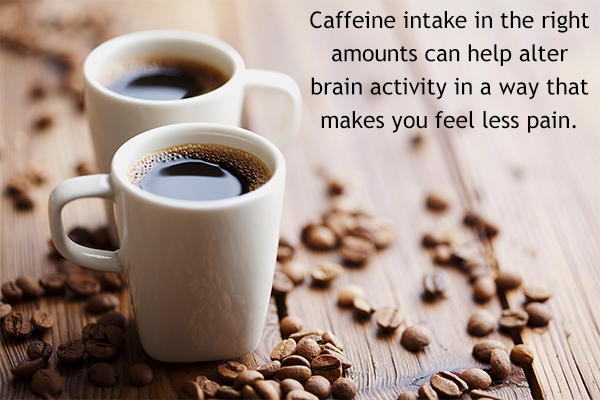
Caffeine intake in the right amounts can alter brain activity in a way that makes you feel less pain. This has been supported by several studies that found caffeine to be particularly useful in reducing the intensity of exercise-induced muscle pain. (6)(7)
How to use:
- Drinking coffee is perhaps the easiest way to get your daily fill of caffeine.
- There are other caffeine-containing products like caffeine chewing gums that can help relieve post-exercise muscle soreness and pain.
- Ask your doctor about starting you on a caffeine supplement, if advisable.
Research suggests that moderate consumption of caffeine, particularly after workout, can help reduce the perception of exercise-related muscle pain by blocking certain pain receptors in the brain. Thus, even though the pain is present, your mind is unable to perceive it giving you a false sense of relief.
4. Get your fill of turmeric through diet and supplements
The healing properties of turmeric are widely recognized in traditional medicine but have gained scientific support as well through numerous studies that have highlighted its anti-inflammatory and analgesic effects. Thus, turmeric when taken in the appropriate amounts can speed up recovery from DOMS and even improve subsequent performance of the affected individual. (8)(9)
How to use:
- Turmeric is a versatile spice that is used in a wide range of dishes and packaged food products like cheese, sauces, and chips. Thus, you can easily incorporate turmeric into your daily diet.
- You can consume turmeric tea or turmeric milk to derive its medicinal virtues.
- If you are unable to meet your recommended dose of curcumin through food intake, you can speak to your doctor about taking turmeric supplements.
The therapeutic potential of turmeric is attributed to its chief component curcumin which has been found useful in the management of exercise-induced inflammation and muscle soreness in several studies.
5. Soak in Epsom salt
Epsom salt, scientifically known as magnesium sulfate, has been found effective in easing muscle stiffness and pain but further studies are needed to understand the exact mechanism behind this therapeutic effect.
The most popular method to use this natural muscle relaxant is to fix yourself a soothing Epsom salt bath.
How to use:
Add a few scoops of Epsom salt in a tub of comfortable warm water, and let your aching body soak in it.
6. Use apple cider vinegar
ACV is yet another remedy for muscle pain that has earned a lot of praise by word of mouth but lacks scientific support.
People use this mildly acidic liquid both internally as well as topically to relieve sore and aching muscles, but excessive use can trigger unwanted side effects. Moreover, concentrated ACV can be too harsh for your insides and therefore must always be diluted with water before consumption.
How to use:
- Simply mix a teaspoon of ACV in a glass of water, add a drop of honey to dampen its sour taste, and consume this tonic.
- External use involves massaging water-diluted ACV onto the affected areas to bring down muscle inflammation and pain.
By and large, ACV is considered safe for consumption and application so long as it’s done in moderation and as advised above. However, there is still a dearth of scientific evidence to know just how effective this remedy actually is for addressing sore muscles.
7. Eat garlic
Garlic is known to exhibit anti-inflammatory and anti-oxidative properties that can be traced back to its main compound allicin. Both these properties can help reduce muscle damage caused by eccentric exercise and the pain and inflammation that results thereafter. (10)
While a lot of general users have found this remedy to be a success, the role of garlic in alleviating muscle pain needs to be explored and verified by further scientific research. (10)
How to use:
As per anecdotal evidence, moderate intake of garlic on a regular basis as part of your diet may help reduce the intensity and frequency of muscle soreness and pain, especially after workouts.
Home Therapies to Relieve Sore Muscles
Here are a few non-medical interventions that can help soothe your painful muscles.
1. Massage the sore areas
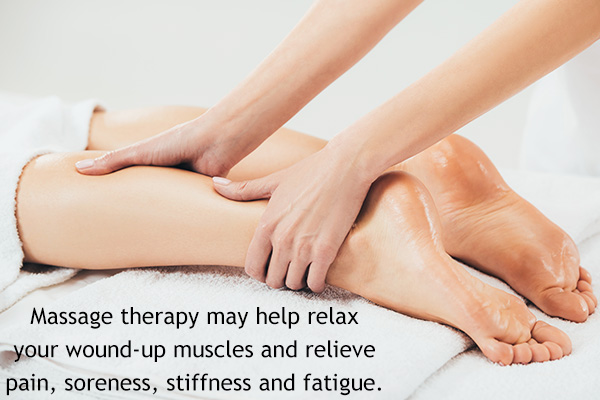
The gentle physical stimulation offered by massage therapy helps improve blood circulation in the targeted area, which brings more nutrition and oxygen to the affected muscles. The increased blood supply can, therefore, help your damaged or tired muscles heal faster and perform better. (11)
2. Use heat therapy
The application of mild topical heat can help increase blood flow to the targeted area and thereby alleviate muscle pain. But you must be careful not to apply excessive heat on a localized area for extended periods as it can leave you with burns. (12)
How to use:
There are many types of warm compresses that can be used for this purpose, like an electric heating pad, a hot water bottle, or something as simple as a cloth soaked in warm water.
You can either buy the compress from the market or make one yourself, but be careful while using it to avoid any undue burns or injuries.
3. Go for a whirlpool bath or hydrotherapy
The ideal form of hydrotherapy for relieving muscle pain is a whirlpool bath which combines the dual benefits of a deep-tissue massage and heat therapy, both of which help enhance blood flow throughout the body to relieve muscle spasms and pain.
How to use:
This intervention involves immersing yourself in a tub of warm, swirling water that massages your body to release muscle tension.
4. Reduce physical stress through relaxation techniques
You can try a number of relaxation techniques, such as deep breathing and mindful meditation exercises to release the stress building inside your body, which is often the source of muscle tension and pain.
5. Make yoga part of your routine
Yoga can help alleviate muscle pain, rebuild muscle strength, and restore full muscle function and mobility without overexerting the affected region.
This claim was corroborated by a 2017 study which found that practicing yoga twice a week helped relieve musculoskeletal pain in dental hygiene students. (13)
Self-Care Tips and Lifestyle Changes to Reduce Muscle Pain
1. Stay active
Muscle strain can make movement difficult but you must keep the affected muscles active without overexerting them in order to retain their full function, or else they start to waste away or shrink.
2. Don’t overexert your body
You must alternate between periods of rest and activity to manage muscle pain. Make sure to get plenty of restful sleep regularly to help your muscles heal. During sleep, your body repairs itself, and so there is no compromising on it.
3. Maintain a healthy weight
Excessive body weight can overburden your muscles, and make you prone to muscle pain. Therefore, you must shed the extra pounds by eating healthy and exercising to find a long-term solution to this problem.
While a low-fat, fibrous diet with proper portion control is the main source of weight loss, a suitable exercise regimen can accelerate this process and help you build extra muscle.
Most-Asked Questions About Muscle Pain
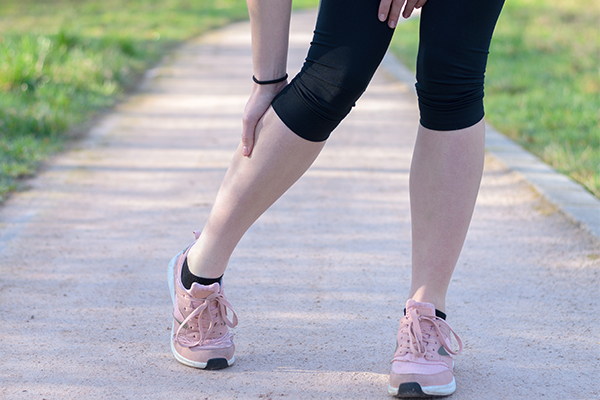
Is muscle pain a symptom of COVID-19?
Current data suggest that COVID-19 primarily affects the respiratory system, but it can take a toll on your entire body and render you weak and tired.
The constant coughing can also strain your chest muscles, in addition to generalized muscle aches all over the body. However, these additional symptoms may not be present in all COVID-19 cases.
Why do I feel pain after exercise?
It is common to experience muscle soreness post-workout, (14) especially if you plunge straight into intense exercises without a proper warmup.
If you make a sudden shift from your regular workout routine, the change can shock your muscles and cause microscopic damage to the muscle fibers. The same is true if you push your muscles to work harder than they are used to in a short duration.
Does diabetes cause occasional muscle pain?
Diabetes is a chronic condition that causes significant nerve damage. This neuropathy, combined with hyperexcitability of the peripheral nerve, can trigger muscular cramps in individuals with diabetes.
Final Word
Muscle pain is a common complaint that can often be relieved through proper lifestyle changes and rest. There are a whole range of causes that can trigger muscle pain, most of which are benign and self-treatable, while others are more severe or systemic and may require medical attention.
One must consult their doctor in case the pain persists despite preliminary care or if it’s accompanied by other serious symptoms.

- Was this article helpful?
- YES, THANKS!NOT REALLY


